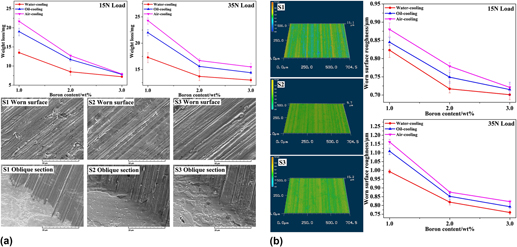Crossref Citations
This article has been cited by the following publications. This list is generated based on data provided by
Crossref.
Ren, Xiangyi
Fu, Hanguang
Xing, Jiandong
and
Tang, Shuli
2018.
Effect of Aluminum on Borocarbides and Temper Softening Resistance of High-Boron High-Speed Steel.
Metallurgical and Materials Transactions A,
Vol. 49,
Issue. 11,
p.
5636.
Ren, Xiangyi
Fu, Hanguang
Xing, Jiandong
Tang, Shuli
and
Zhang, Qi
2018.
Effect of calcium modification on solidification, heat treatment microstructure and toughness of high boron high speed steel.
Materials Research Express,
Vol. 6,
Issue. 1,
p.
016540.
Ran, Cui
Yanhai, Cheng
Xianliang, Meng
Shizhe, Feng
and
Zhengtong, Han
2018.
Microstructure and properties of heat treated 1Cr17Ni4MoB steel fabricated by laser melting deposition.
Optics & Laser Technology,
Vol. 108,
Issue. ,
p.
59.
Yi, Yanliang
Xing, Jiandong
Li, Wei
Liu, Yangzhen
and
Zheng, Baochao
2019.
Effect of Matrix Microstructure on Abrasive Wear Resistance of Fe–2 wt% B Alloy.
Tribology Transactions,
Vol. 62,
Issue. 6,
p.
971.
Ren, Xiangyi
Fu, Hanguang
Xing, Jiandong
and
Yi, Yanliang
2019.
Effect of solidification rate on microstructure and toughness of Ca-Ti modified high boron high speed steel.
Materials Science and Engineering: A,
Vol. 742,
Issue. ,
p.
617.
Ren, Xiangyi
Fu, Hanguang
Xing, Jiandong
and
Yi, Yanliang
2019.
Research on high-temperature dry sliding friction wear behavior of Ca Ti modified high boron high speed steel.
Tribology International,
Vol. 132,
Issue. ,
p.
165.
Ren, Xiangyi
Fu, Hanguang
and
Xing, Jiandong
2019.
Formation of Eutectic Borocarbides in High Boron High Speed Steel during Non‐Equilibrium Crystallization.
steel research international,
Vol. 90,
Issue. 2,
Yi, Yanliang
Li, Qiang
Xing, Jiandong
Fu, Hanguang
Yi, Dawei
Liu, Yangzhen
and
Zheng, Baochao
2019.
Effects of cooling rate on microstructure, mechanical properties, and residual stress of Fe-2.1B (wt%) alloy.
Materials Science and Engineering: A,
Vol. 754,
Issue. ,
p.
129.
Yuan, Zhentao
Jiang, Yehua
Li, Lu
and
Li, Zulai
2019.
The microstructure and high-temperature tribology behavior of high boron HSS under different heat treatments.
Industrial Lubrication and Tribology,
Vol. 71,
Issue. 2,
p.
212.
Yuan, Zhentao
Xiaoyu, Chong
Yudong, Sui
Jiang, Yehua
and
Yannan, Zhang
2019.
Precipitation behavior of boron-carbide hard phase comprising a new high-boron high-speed steel.
Materials Research Express,
Vol. 6,
Issue. 10,
p.
106516.
Li, Kemin
Huang, Zhifu
Wang, Shaofei
Shen, Yupeng
Wang, Wenke
and
Jian, Yongxin
2019.
Effect of oxidation time on the short time oxidation behavior and tribological performance of bulk Fe2B.
Materials Research Express,
Vol. 6,
Issue. 10,
p.
106506.
Emami, Mohammad
Askari-Paykani, Mohsen
Farabi, Ehsan
Beladi, Hossein
and
Shahverdi, Hamid Reza
2019.
Development of New Third-Generation Medium Manganese Advanced High-Strength Steels Elaborating Hot-Rolling and Intercritical Annealing.
Metallurgical and Materials Transactions A,
Vol. 50,
Issue. 9,
p.
4261.
Lu, Jue
Song, Yanli
Hua, Lin
Zhou, Pu
and
Xie, Guangju
2019.
Effect of temperature on friction and galling behavior of 7075 aluminum alloy sheet based on ball-on-plate sliding test.
Tribology International,
Vol. 140,
Issue. ,
p.
105872.
Yi, Yanliang
Xing, Jiandong
Ren, Xiangyi
Fu, Hanguang
Li, Qiang
and
Yi, Dawei
2019.
Investigation on abrasive wear behavior of Fe B alloys containing various molybdenum contents.
Tribology International,
Vol. 135,
Issue. ,
p.
237.
Sharma, Mamta
Ortlepp, Isabell
and
Bleck, Wolfgang
2019.
Boron in Heat‐Treatable Steels: A Review.
steel research international,
Vol. 90,
Issue. 11,
Wang, Biao
Zhong, Honggang
Li, Xihao
Wang, Xiebin
Wu, Tieming
Liu, Qingmei
and
Zhai, Qijie
2019.
Thermal Simulation Study on the Solidification Structure and Segregation of a Heavy Heat-Resistant Steel Casting.
Metals,
Vol. 9,
Issue. 2,
p.
249.
Ju, Jiang
Yang, Chao
Ma, Shengqiang
Kang, Maodong
Wang, Kaiming
Li, Jingjing
Fu, Hanguang
and
Wang, Jun
2020.
Effect of temperature on oxidation resistance and isothermal oxidation mechanism of novel wear-resistant Fe-Cr-B-Al-C-Mn-Si alloy.
Corrosion Science,
Vol. 170,
Issue. ,
p.
108620.
Sukhova, O.V.
2020.
STRUCTURE AND PROPERTIES OF Fe-B-C POWDERS ALLOYED WITH Cr, V, Mo OR Nb FOR PLASMA-SPRAYED COATINGS.
Problems of Atomic Science and Technology,
p.
77.
Pan, Yu
Pi, Ziqiang
Liu, Bowen
Xu, Wei
Zhang, Ce
Qu, Xuanhui
and
Lu, Xin
2020.
Influence of heat treatment on the microstructural evolution and mechanical properties of W6Mo5Cr4V2Co5Nb (825 K) high speed steel.
Materials Science and Engineering: A,
Vol. 787,
Issue. ,
p.
139480.
2020.
Liquidus Surface and Spinodal of Fe-B-C Alloys.
East European Journal of Physics,




